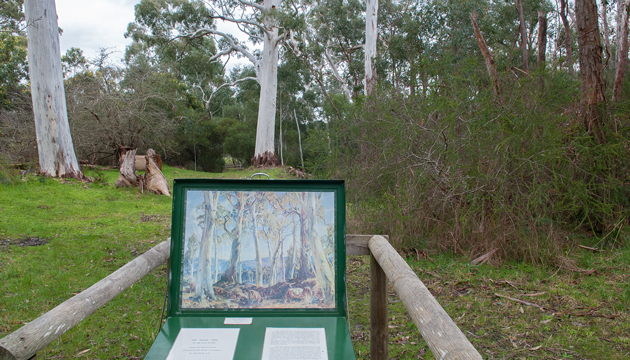Wander through the gorgeous South Australian estate of painter Hans Heysen, The Cedars, and you too can revere the very trees he painted 100 years ago.
Story + photos Ken Eastwood
There’s something pretty special about standing in a forest, looking down at a painting produced by one of Australia’s best landscape artists, and then looking back up at the very tree featured. The eucalypt itself may be 80 or 90 years older than its likeness, but its form is unmistakable, and the colours and play of light across the bark with the change of day are those that Hans Heysen lovingly recreated in scene after scene painted at his estate near Hahndorf in the Adelaide Hills.
This is one of the enchanting experiences that you can enjoy at The Cedars. Special artist podiums are set up at various points, with a reproduction of one of Heysen’s artworks facing the exact scene that he painted. And although the foreground cows or ducks may be missing, or the low-growing vegetation may have changed, many of the main trees – candlebarks, red gums, blue gums, stringybarks and pink gums – are still there.
Hans Heysen is one of Australia’s greatest artists, winning the Wynne Prize nine times, and receiving an OBE in 1945. He grew up in Germany and Australia and studied in Europe for four years from 1899 before returning to Australia. Proficient in charcoals, oils, watercolours and pastels, he mixed with the likes of Dame Nellie Melba, Marcel Marceau, Laurence Olivier and Vivienne Leigh.
When Heysen bought the 13-hectare property in 1912, he loved the surrounding bushland so much that he kept adding parcels of land to save nearby trees from being cut down, and paid council and landowners not to log other trees. The property is now 60ha, and incorporates an orchard, a cottage garden around the homestead, and Heysen’s beautiful stone and wood studio, which has easel markings in the carpet, showing where Heysen moved around to catch the light. But much of the property is a stringybark heath forest, where sculptures lurk among the grand old trees.
“He is known as an artist but he was really an avid conservationist,” says Trevor Curnow, coordinator of Trees Please!, a small group of volunteers who over 20 years have planted 5000 new trees and spent nearly every Thursday weeding out broom, gorse and blackberry. “The planting trees is the romantic, interesting bit, but 90 per cent of the work is weeding,” he says. “But when The Cedars gets in your blood it’s a bit of a magnet.”
This story excerpt is from Issue #116
Outback Magazine: December/January 2018










